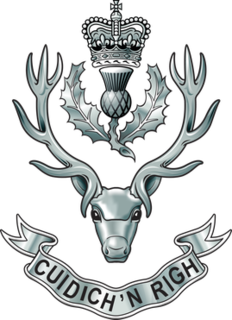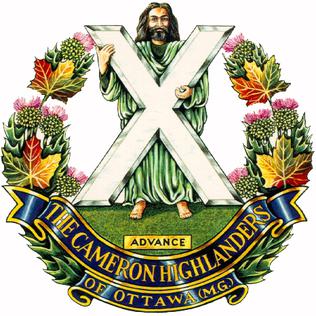Related Research Articles

The Dean Cemetery is a historically important Victorian cemetery north of the Dean Village, west of Edinburgh city centre, in Scotland. It lies between Queensferry Road and the Water of Leith, bounded on its east side by Dean Path and on its west by the Dean Gallery. A 20th-century extension lies detached from the main cemetery to the north of Ravelston Terrace. The main cemetery is accessible through the main gate on its east side, through a "grace and favour" access door from the grounds of Dean Gallery and from Ravelston Terrace. The modern extension is only accessible at the junction of Dean Path and Queensferry Road.

Norman Archibald Macrae (N.A.M.) MacKenzie, was the President of the University of British Columbia from 1944 to 1962, and a Senator from 1966 to 1969.

Lieutenant-Colonel Donald Dickson Farmer VC MSM was a Scottish recipient of the Victoria Cross, the highest and most prestigious award for gallantry in the face of the enemy that can be awarded to British and Commonwealth forces.

Clan Mackenzie is a Scottish clan, traditionally associated with Kintail and lands in Ross-shire in the Scottish Highlands. Traditional genealogies trace the ancestors of the Mackenzie chiefs to the 12th century. However, the earliest Mackenzie chief recorded by contemporary evidence is Alexander Mackenzie of Kintail who died some time after 1471. Traditionally, during the Wars of Scottish Independence, the Mackenzies supported Robert the Bruce, but feuded with the Earls of Ross in the latter part of the 14th century. During the 15th and 16th-centuries the Mackenzies feuded with the neighboring clans of Munro and MacDonald. In the 17th century the Mackenzie chief was made Earl of Seaforth in the peerage of Scotland. During the Scottish Civil War of the 17th century the Mackenzies largely supported the Royalists. During the Jacobite rising of 1715 the chief and clan of Mackenzie supported the Jacobite cause. However, during the Jacobite rising of 1745 the clan was divided with the chief, Kenneth Mackenzie, Lord Fortrose, supporting the British-Hanoverian Government and his relative, George Mackenzie, 3rd Earl of Cromartie, supporting the Jacobites.

The Gordon Highlanders was a line infantry regiment of the British Army that existed for 113 years, from 1881 until 1994, when it was amalgamated with The Queen's Own Highlanders to form The Highlanders. Although the 'Gordon Highlanders' had existed as the 92nd Regiment of Foot since 1794, the actual 'Gordon Highlanders Regiment' was formed in 1881 by amalgamation of the 75th (Stirlingshire) Regiment of Foot and 92nd Regiment of Foot.

The Queen's Own Highlanders , officially abbreviated "QO HLDRS," was an infantry regiment of the British Army, part of the Scottish Division. It was in existence from 1961 to 1994.

The Cameron Highlanders of Ottawa is a Canadian Army Primary Reserve infantry regiment.

The Liverpool Scottish, known as "the Scottish", was a unit of the British Army, part of the Army Reserve, raised in 1900 as an infantry battalion of the King's. The Liverpool Scottish became affiliated to the Queen's Own Cameron Highlanders in the 1920s and formally transferred to the regiment in 1937 with its identity preserved. Reflecting the Territorial Army's decline in size since the late 1940s, the battalion was reduced to a company in 1967, then to a platoon of "A" (King's) Company, King's and Cheshire Regiment in 1999. In 2006, the company was incorporated into the 4th Battalion, Duke of Lancaster's Regiment.

Clan Cameron is a West Highland Scottish clan, with one main branch Lochiel, and numerous cadet branches. The Clan Cameron lands are in Lochaber and within their lands lies Ben Nevis which is the highest mountain in the British Isles. The Chief of the clan is customarily referred to as simply "Lochiel".

The Seaforth Highlanders was a line infantry regiment of the British Army, mainly associated with large areas of the northern Highlands of Scotland. The regiment existed from 1881 to 1961, and saw service in World War I and World War II, along with many smaller conflicts. In 1961 the regiment was amalgamated with the Queen's Own Cameron Highlanders to form the Queen's Own Highlanders, which merged, in 1994, with the Gordon Highlanders to form the Highlanders. This later joined the Royal Scots Borderers, the Black Watch, the Royal Highland Fusiliers and the Argyll and Sutherland Highlanders to create the present Royal Regiment of Scotland.

The Queen's Own Cameron Highlanders or 79th Regiment of Foot was a line infantry regiment of the British Army, raised in 1793. It amalgamated with the Seaforth Highlanders to form the Queen's Own Highlanders in 1961.

The Battle of Mulroy was a Scottish clan battle fought in August 1688 in the Lochaber district of Scotland. It was fought between the Clan Mackintosh who were supported by government troops under Kenneth Mackenzie of Suddie against the Clan MacDonald of Keppoch who were supported by the Clan Cameron over disputed lands in the Braes of Lochaber. The battlefield has been inventoried and protected by Historic Scotland under the Scottish Historical Environment Policy of 2009.
Sir George Munro of Culcairn was a Scottish soldier of the 18th century from Ross-shire, Scotland. He commanded the 3rd Independent Highland Company from 1714 to 1716, fought at the Battle of Glen Shiel in 1719, led the 6th Company in formation of the "Black Watch" in 1725, the 8th Company of Black Watch when it was regimented in 1739 and again commanded an Independent Highland Company in 1745–46. He was shot in error in 1746.
The 71st Regiment of Foot was a regiment of infantry raised in 1775, during the American Revolutionary War and unofficially known as Fraser's Highlanders. It was disbanded in 1786.
The 152nd Infantry Brigade was an infantry brigade of the British Army that fought during both the First and the Second World Wars.
Mackenzie, Mckenzie, MacKenzie and McKenzie are alternative spellings of a Scottish surname. It was originally written MacKenȝie and pronounced [məˈkɛŋjiː] in Scots, with the "z" representing the old Middle Scots letter, "ȝ" yogh. This is an anglicised form of the Scottish Gaelic MacCoinnich, which is a patronymic form of the personal name Coinneach, anglicized as Kenneth. The personal name means "comely".

Clan Munro is a Highland Scottish clan. Historically the clan was based in Easter Ross in the Scottish Highlands. Traditional origins of the clan give its founder as Donald Munro who came from the north of Ireland and settled in Scotland in the eleventh century, though its true founder may have lived much later. It is also a strong tradition that the Munro chiefs supported Robert the Bruce during the Wars of Scottish Independence. The first proven clan chief on record however is Robert de Munro who died in 1369; his father is mentioned but not named in a number of charters. The clan chiefs originally held land principally at Findon on the Black Isle but exchanged it in 1350 for Estirfowlys. Robert's son Hugh who died in 1425 was the first of the family to be styled "of Foulis", despite which clan genealogies describe him as 9th baron.
The Independent Highland Companies were irregular militia raised from the Scottish clans of the Scottish Highlands by order of the Government between 1603 and 1760 in order to help keep the peace and enforce the law in the Highlands and were recognized as such by the Government. The officers of the Independent Highland Companies were commissioned as officers of the British Army but the Independent Companies were not recognized as official regiments of the line of the army. The Independent Highland Companies were the progenitors of the Highland Regiments of the British Army that began when ten Independent Highland Companies were embodied to form the Earl of Crawford's Highland Regiment that was numbered the 43rd Regiment of Foot in 1739.
Percy Arthur Paul Peter MacKenzie was a Scottish physician, soldier and sportsman. He was a pioneer of modern sports medicine. He was the founder of the Glenshee Ski Rescue Service and joint founder of the British Association of Sports Medicine.
Iain mac Mhurchaidh, alias John MacRae, was a Scotland-born Bard from Kintail, a member of Clan Macrae, and an early immigrant to the Colony of North Carolina. MacRae has been termed one of the "earliest Scottish Gaelic poets in North America about whom we know anything."
References
- ↑ "Captain Archibald Donald MacKenzie | Christ Church, Oxford University". www.chch.ox.ac.uk. Retrieved 16 November 2019.
- 1 2 "Mackenzie, Archibald Donald". www.winchestercollegeatwar.com.
- ↑ "Capt Archibald Donald MacKenzie". Find a Grave. Retrieved 16 November 2019.
- ↑ Hullis, Shaun (November 2019). "Donny Mackenzie - a hero in Italy" (PDF). The Trusty Servant. 128: 10.